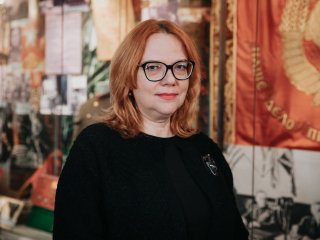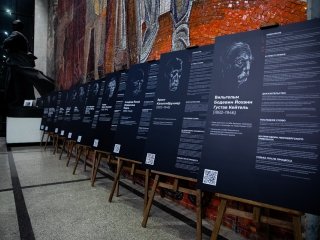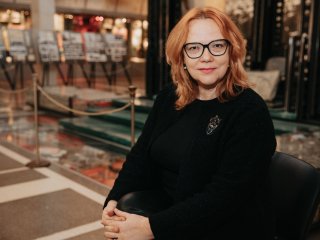In the coming days, our country will celebrate one of its most important holidays: Defender of the Fatherland Day. On the eve of this event, Scientific Russia visited the Central Museum of the Armed Forces of the Russian Federation, where the exhibition Nuremberg: Casus Pacis, dedicated to the Nuremberg trials, takes place. Natalia Borisovna Osipova, a journalist and head of the Nuremberg: Casus Pacis project, talks about how the famous trial of the Nazis took place, and about the project.
─ When I researched the materials of the Nuremberg trials, I was struck by the ostentatious self-confidence and aloofness of the accused, the absence of any signs of remorse and doubt. And what surprised you the most when you worked with the materials of the Nuremberg trials?
─ The Nuremberg trials were very dramatic; you could see the clash of good and evil firsthand. What we know about Nazism is textbook truth today: we all know how many people were killed, what happened in concentration camps, we have heard about these gas chambers and the monstrous burning of people alive in furnaces, about the ramming of people in firing ditches… All these technological details of Nazism, each a crime in itself. But in 1945, when the Nuremberg trials had just begun, the world did not yet know all these disgusting details. All this was only at the level of rumors, and there was no firm certainty…
─ It was even said that the USSR exaggerated the scale of Nazi atrocities to pursue its own interests.
The Nuremberg trials were the first trials in the history of mankind on crimes against peace and humanity. The trial of the former leaders of Nazi Germany began on November 20, 1945, at the International Military Tribunal in Nuremberg (Germany). The Nuremberg trials lasted a little less than a year
─ Indeed. Moreover, one of Goering’s theses was the thesis that the Soviets themselves shot their own people during the repression, and now they attribute it to us, the Germans. That is, the world at that time was really in a state of ignorance about the real scale of the Nazi crimes. So, it was the Nuremberg trials that revealed to the world the monstrous crimes of Nazism, and everyone found out what it really was. And the work of journalists was very important here. The reporters present in the courtroom, let me remind you that about 250 out of more than 300 seats were given to journalists, among whom were famous writers, the brightest journalists, cartoonists of their time who told the whole world about the monstrous crimes of Nazism.
A new political and human rights reality was being formed in the Nuremberg courtroom. A man stood at the center of the world: his pain, his life, and his interests. For the first time, it was said that it is impossible to transgress the norms of humanity, no matter what goals, geopolitical, economic, and others, are at stake. The very concept of a crime against humanity was first coined during the Nuremberg trials.
─ As well as the word “genocide.”
─ Yes, within the framework of the project we have studied this issue in detail. During the preparation and conduct of the trials, two legal concepts collided, which we often perceive as one, but purely from the point of view of law they are different: crimes against humanity and genocide. The question arose as to what exactly to incriminate the Nazis. It was decided that the charges would include the wording “crimes against humanity,” but the Chief U.S. Prosecutor Robert H. Jackson also introduced the term genocide. The legal definition of the concept of genocide will be established immediately after the process of adoption by a UN General Assembly Resolution on December 13, 1946. This is the most important thing.
Another important thing that struck me was the conclusions of psychologists and psychiatrists who worked with prisoners. Throughout the whole process, psychologists monitored Nazi criminals, interviewed them, which is reflected in their memories, reports. Psychiatrists Douglas Kelly and Leon N. Goldensohn worked with the Nazis, as well as Gustave Gilbert, a psychologist. One of the tasks of such interviews was to understand whether these criminals are mentally healthy and how do they feel about what they have done. We studied this issue in detail, and for me, it was one of the most important, both professionally and humanly.
─ And what did these studies show?
Numerous studies by psychologists and psychiatrists revealed a horrible picture: Nazi criminals were completely sane, they had high IQ, they were talented, bright, intelligent, educated people who turned all their virtues to the service of evil. Unfortunately, the idea that the Nazis were some kind of stupid villains, primitive creatures, does not correspond to reality.
This is what shocked me the most when I worked with the materials of the Nuremberg trials. These people never repented. Even when convincing evidence was presented, when the world learned about the depth of these crimes and these monstrous technologies, the leaders of the Third Reich remained steadfast. Until the last minutes of their lives, they swore allegiance to Germany or Hitler, saying that they were right anyway. The Nazis perceived their atrocities as a form of service to the motherland.
It’s really scary because we always live in a kind of illusion that evil will be punished sooner or later, that sooner or later repentance will come to the villains. But some people will never repent and will do evil intentionally while staying in full mental health. It’s really scary, and I never thought that our project would lead me to such a sad truth.
─ It is no secret that adherents of Nazism, from ordinary soldiers to the ruling elite, regularly used drugs in large quantities. Do you think this could have contributed to the fact that these people stopped distinguishing between good and evil?
─ Well, Goering, for example, was indeed a drug addict with experience. But during the Nuremberg trials, he had no opportunity to get drugs, and nevertheless, he did not give up his views. I think that he committed all his crimes in a completely sane mind and with a firm memory. Of course, there were heavy drinkers and avid drug addicts among the Nazis, who, perhaps, tried to solve some of their psychological problems in this way, to minimize what could be called the voice of conscience or simply indulged their instincts.
Nazism generally liberates the lowest instincts in a person, it is based on this. The top of the Reich existed in a state of intoxication with power, blood, permissiveness. But it seems to me that no doping could have influenced the choice of these people, and it would be wrong to attribute responsibility for their actions to substances. And psychiatrists have recorded their complete sanity and full awareness of the crimes committed.
ATTENTION! Drug use harms your health and poses a threat to your life.
─ Goering said that the entire Nuremberg trial was a kangaroo court staged by the winners for the losers. But it is important to understand that the Nuremberg trial was not a Lynch trial, but a real trial with evidence, witness testimony, involving lawyers to defend the accused, and so on. The documentaries from concentration camps alone demonstrate it.
─ And it’s not just the documentaries that made people feel bad in the courtroom and amaze with their creepy scenes. Some of the other evidence was brought into the courtroom and caused no less a flurry of indignation. The gold crowns of the murdered people, their hair, which was used to stuff mattresses, pieces of human skin with tattoos – all this was demonstrated to those who were in the courtroom. One of the most terrible proofs was the severed head of a man from the Buchenwald concentration camp, which lost its original size and shape – it was turned into a paperweight, which was used by the camp commandant Karl-Otto Koch. This evidence was presented in Courtroom 600 by the American prosecutor Thomas J. Dodd.
For us, these are terrible, unimaginable things, but for the concentration camp, it was everyday life. The audience was shocked. The accused themselves turned away and did not want to look at it. However, not everyone – someone kept their equanimity at this moment.
The prosecutors and judges of the Nuremberg trials, which lasted almost 11 months, were represented by four states: the USSR, the US, the UK, and France.
The documentaries you are talking about were also part of the evidence. On November 29, 1945, the American prosecution showed the court a film edited from newsreels filmed in the camps. The Soviet side also decided to actively use visual evidence, and urgently created a film made by the best Soviet cinematographers. The work was led by the famous Soviet cameraman and director Roman Karmen, the film was based on documentary footage shot by Soviet cameramen in liberated cities, concentration camps. These are the very first shots after the liberation – what the army saw immediately after the occupiers left. On February 19, the audience of Courtroom 600 saw this documentary – Film Documents of the Atrocities of the German Fascist Invaders. So far, we’ve only seen fragments: it has never been aired in full since.
These are terrible shots: mountains of murdered prisoners of war, prisoners of concentration camps, prison yards strewn with the bodies of shot people, children, and adults dying of dystrophy, disfigured faces of children with stars carved on their foreheads, guillotines, basins with severed human heads, ovens, bags of hair that were going to be used for mattresses, mountains of crowns, women and old men sobbing over the bodies of loved ones. There are also the very first shots of the ditches of Babi Yar being opened. It’s the scariest film I’ve ever seen.
─ Is it possible to call the perpetrators of these atrocities mere pawns who carried out the will of the authorities?
─ Of course not. It was during the Nuremberg trials that the dilemma of “just following orders” was finally put to an end. The court ruled that you have no right to carry out an unlawful order, and if you do, you will be judged in accordance with the law. Responsibility for obeying an order lies not only with the one who gives the order, but also directly with the one who obeys. International criminal law follows from the Nuremberg trials, and the decisions taken and legally recorded in Nuremberg, including the principle of personal responsibility of any soldier, greatly influenced the further development of international law and humanitarian law.
In fact, the whole concept of human rights came out of Nuremberg, just like Russian literature came from The Overcoat by Gogol. And this concept was created by Soviet lawyers and legal scholars who, together with their allies, stood up for the victims of Nazism.
─ Natalia Borisovna, tell us about your Nuremberg: Casus Pacis international multimedia project. How long have you been working on it? What makes it unique?
─ We launched the project quite quickly, literally after three months of preliminary work; the portal opened, and the public work of the project began on the eve of the 75th anniversary of the trials – November 19, 2020. We completed the work on December 8, 2021, with the opening of an exhibition with unique works by Nikolay Zhukov, a witness to the Nuremberg trials.
We have done a lot of work with archives, scientists, worked with personal collections, conducted our own research: about journalism at the Nuremberg trials, about translators at the trials, even about black humor associated with Nazism. Our work of a small group of journalists passionate about the topic was supported by the huge media force of MIA Rossiya Segodnya: without their participation, the project would never have taken place.
During our work, we met many wonderful people: politicians, film directors, public figures, experts, for example, the wonderful enthusiast Sergey Miroshnichenko, who translates the transcripts of the Nuremberg trials into Russian from English. His translations helped us a lot because we entered the project without having the full text of the Nuremberg transcript in Russian. It simply does not exist at the moment.
The exhibition Nuremberg. Casus Pacis in drawings by Nikolay Zhukov. While in the courtroom, Soviet artist Nikolay Zhukov made sketches. The famous Shadows of the Past or Black Collection series was created in 1971 shortly before the death of the artist, based on those sketches and personal memories. The drawings are of great artistic and historical value and have not been demonstrated before. Source: Elena Librick / Scientific Russia
Another important discovery was made by our colleagues from Sputnik Kazakhstan, who managed to find a translator, a war veteran who took part in the Nuremberg trials. In her interviews, she told us how the trials took place, how life was arranged at the trial, how life, communication, friendship was arranged. We specifically asked colleagues to ask her not only important questions about the trials and translations but also everyday ones: about how they, the girls of her generation, coped with everyday situations in the destroyed post-war Nuremberg. After all, and this is a well-known fact, officials even reported this to Moscow, representatives of the Soviet delegation sometimes had nothing to wear to the courtroom, they looked very modest compared to foreigners. And our translator didn’t even have normal shoes at that moment: she had to improvise on the spot.
While working on the project, we collected everyday stories of different people involved in the process. Roman Rudenko’s grandson Mikhail Amirdzhanov shared with us a unique story about how his grandfather was preparing for the trial. A Jewish tailor whose relatives died in the Holocaust made his suit to the nines, in record time, and left a note in his pants pocket that read “Judge them! Punish them!”
Yes, the war was a long time ago, 75 years have passed: for the most part, the perpetrators and victims of this war are already dead. It seems that all the dots are set, and everyone understands that Nazism is bad. But in fact, this is not the case, and one of the main lessons that we learned from the project, communicating with a variety of people, is that Nazi ideology and practices tend to come back. And if you don’t talk about what good and evil are on a daily basis, then these lines can blur in people’s minds.
There are many of our compatriots, as it turned out, who manage to find even some positive aspects of Nazism, are fond of mysticism and occult research, have an unhealthy interest in the secrets of Ahnenerbe (a German think tank for the study of ancient German history and ancestral heritage), do not trust the completely official and scientific version of the history of Nazism. It’s amazing, but it’s a fact. As the defendant Hans Fritzsche, the main mouthpiece of Nazi propaganda, said during the trial: “If you think this is the end, you are mistaken. On the contrary, this means the beginning of the Hitler legend.” And so, it turned out. That’s why we considered it the most important task to make such a project. Over time, history is distorted, and in a fantasy way, therefore, I and my colleagues believe that it is very important to preserve, record, and transmit the memory of all the atrocities committed by the Nazis.
Of course, the verdict of the Nuremberg trials could have been tougher. Unfortunately, three Nazis were acquitted, including Hans Fritzsche, the Soviet Union did not agree with this, expressed its dissenting opinion, but this did not change the case. Unfortunately, some Nazis eventually died in their beds, even living to an advanced age, like Hitler’s chief architect and Minister of War Industry Albert Speer. And yet, despite all the disadvantages, the process took place, the process was legitimate, competitive, open. Nazism was condemned.
The people who prepared the Nuremberg trials, who participated in the Nuremberg trials – European intellectuals, representatives of allied countries – were able to bring the matter to an end, and in very difficult conditions, both social and political: the verdict was passed after Winston Churchill’s Iron Curtain speech, which launched the Cold War and strained relations between the powers. And in this ability to bring to the final the trial of the chief Nazis, I believe, is their great professional and personal human merit of these great people of their time, representatives of the war generation. Of course, it was the will of the governments of the participating countries, but nevertheless, any act, any imbalance could have destroyed the fragile consensus, which is why contacts and cooperation of these people on a personal level were so important. Their personal choice was in condemning Nazism, in understanding the common goals of the world, in understanding the spirit of the era. Nuremberg was their most important achievement, their contribution to the world that we still use and that we should value and cherish.




































